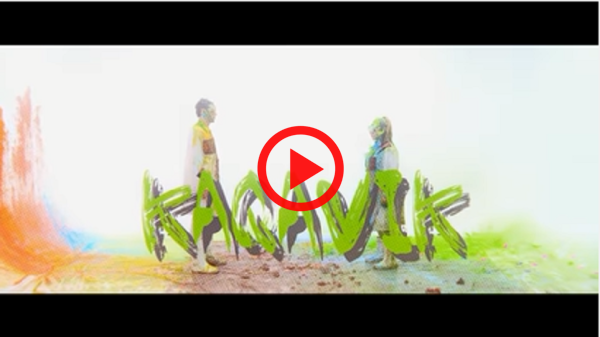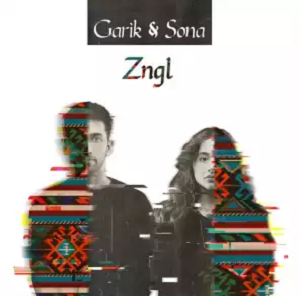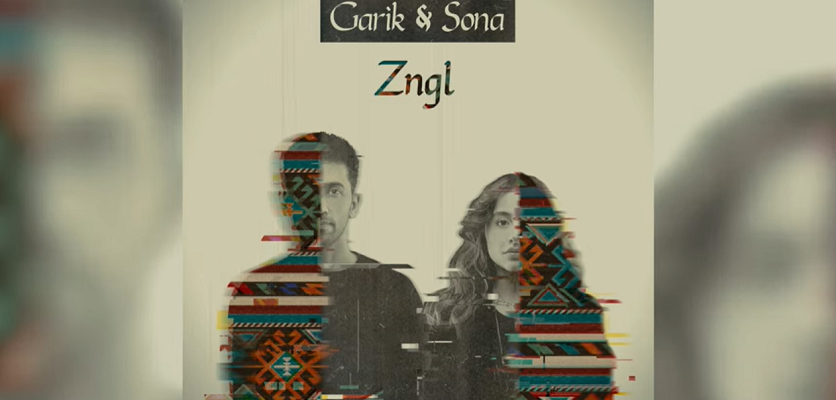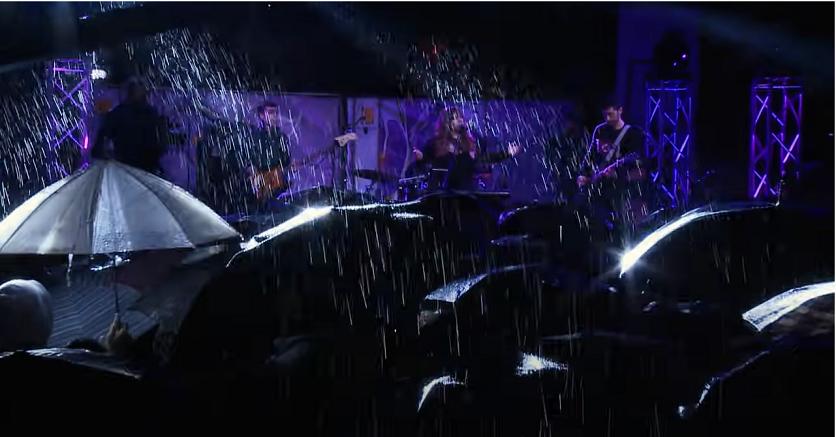Garik & Sona: Clinking their way through Armenian folk music dreams
February 10, 2022
Newly available on YouTube are ten songs from “Zngl,” the debut album Garik & Sona were shy to release until the summer of 2021. Finally, catchy hooks and dynamic melodies add up to an album full of Armo-folk songs you won’t mind getting stuck in your head. What makes Garik & Sona stand out from other similar bands? More importantly, what is their impact on Armenian folk music? H-pem has had the chance to sit down and interview Garik Papoyan and Sona Rubenyan after a sold-out concert. Check out our exclusive interview below!
Ever since audiences flocked to a rainy Aznavour Square to watch Garik & Sona’s debut public concert in 2017, this folk-rock band from Armenia continues to perform refreshing covers of iconic songs attracting fans in droves.
We must have seen all the aunties and uncles singing along Garik & Sona’s Armo-folk renditions of timeless songs and all the youngsters clapping their hands to the music they enjoy.
Pop singers have been making covers of songs from folk genres since the 1990s. It’s a unique phenomenon that Garik & Sona can touch audiences to their cores without any conscious effort on their part. Effortless vocal flair, strong sense of rhythm, upbeat style, and fun approach make this duo a sure-fire hit!
 Garik & Sona's humorous rendition of "Kaqavik," Komitas Vardapet's original song premeired on Mar. 21, 2021 (Screenshot: Garik Papoyan YouTube page)
Garik & Sona's humorous rendition of "Kaqavik," Komitas Vardapet's original song premeired on Mar. 21, 2021 (Screenshot: Garik Papoyan YouTube page)Together they make songs filled with humor and heart. Their latest video single is a light and witty take on “Kaqavik” ("Կաքաւիկ" | Young Partridge) originally by Komitas Vardapet. Over the years, Garik & Sona have garnered high engagement and followers on music streaming platforms like SoundCloud, Spotify, and Anghami. Their artistry fuses pop-rock and electronic music with folk lyrics like “Esor Urbat e” ("Էսօր Ուրբաթ է" | Today is Friday), and “Qamin zana” ("Քամին զանա" | May the Gusting Winds Blow), to create contemporary dance music with a subtle organic touch.
According to Sona, “Garik was to blame” for the delay in releasing an album. Garik of course had his own reasons for not rushing: “Time is scarce, we prefer to make new songs and release singles,” he told h-pem. “We’ll just keep on recording until we have enough songs to make up an album.”
Garik & Sona ventured into the Armenian music scene with their stellar “Lusin” ("Լուսին" | Moon). What may come as a revelation, however, is that something else has become the band's defining song.
What’s Garik & Sona’s defining song?
Take a guess and find the answer in our heartwarming interview here!
 Garik Papoyan to h-pem: "I feel sort of proud that we have a wide appeal across different generations because we are committed to our music and create music that does not target any age group" (Screenshot: Concert flyer )
Garik Papoyan to h-pem: "I feel sort of proud that we have a wide appeal across different generations because we are committed to our music and create music that does not target any age group" (Screenshot: Concert flyer )
Loucig Guloyan-Srabian: Both young and grown-up audiences will move their heads to the rhythm of the songs you’re playing. What does this mean to you as the leader of the band and arranger of several titles? Is it important? How has it evolved? How does it connect to what you hope to be?
Garik Papoyan: I feel sort of proud that we have a wide appeal across different generations because we are committed to our music and create music that does not target any age group. We started making music together because we love it and because it means something to us. Whenever we got together for rehearsals, I would offer something exciting and new. It was a labor of love. We didn’t think about staging concerts. However, once on stage, we quickly realized that there was a strong chemistry between the audience and the band. We have no clue how this happened. People are very much into our music. The older generation loves our music because Sona delivers authentic renditions of well-known Armenian folk songs; it catches on with the young because it sounds trendy and the younger generation is drawn to the mix of familiar modern instruments. Everyone takes something home, without any deliberate or conscious effort on our part!
 “Zngl" is Garik & Sona's debut album. It is available on major musical platforms.
“Zngl" is Garik & Sona's debut album. It is available on major musical platforms.
L.G.S.: What makes you stand out from other Armo-folk bands?
G.P.: Folk songs have been around for centuries. People have always made covers of songs. It’s hard to tell why certain covers work over others, but your audience will be able to pick up on the degree of authenticity and react accordingly. Some covers have disappeared altogether; others have been cherished. It’s not up to us to evaluate. The audience will filter out the fake from the real.
L.G.S.: Putting together a catchy musical arrangement is an art unto itself and it can enhance the original song. How do you give your mashups a unique touch? Do you try and choose between different possibilities?
G.P: I arrange a song from start to finish. It’s like painting in a studio and displaying the finished product. You can call me egocentric, but I never bring half-finished songs to Sona or to the band. When they get into the studio to practice, the songs are practically already written. They usually like the combination of the parts and perform it smoothly together. Since I was young, I have been obsessed with reimagining and reworking songs that I find less compelling musically. But I never cared about sharing them with the world. However, at some point, I asked my wife if she would sing the songs I had been arranging. We practiced together at home—she sang while I accompanied her on the piano. Soon we had compiled a collection of songs and she suggested that I give a concert. I love performing but I cannot sing at all. I never imagined that someone like Sona would come along and be willing to sing the arrangements.
I arrange a song from start to finish. It’s like painting in a studio and displaying the finished product.
Garik Papoyan
L.G.S.: How could you tell Sona Rubenyan was the right choice to perform your songs?
G.P.: The first time I heard Sona sing was at the Armenian Hay Superstar competition. It was five years before our project started. While serving as a judge, I was amazed at the beauty of her voice. She won the competition, and it occurred to me that we should collaborate. But I was too busy. Music was just a hobby for me until I realized that I had a bunch of songs that were starting to pile up. I remembered there was this sweet voice that I liked, so I called Sona. She was giving solo concerts and was looking for a band. We teamed up together and rehearsed for a year solid before performing live.
 Gark Papoyan to h-pem: "The audience will filter out the fake from the real" (Screenshot: Concert flyer)
Gark Papoyan to h-pem: "The audience will filter out the fake from the real" (Screenshot: Concert flyer)
L.G.S.: Sona, could you tell us a bit about why did you choose to work with Garik and the journey you've been on together?
Sona Rubenyan: I was overwhelmed by the praise and positive feedback I received from Garik at the Hay Superstar competition. Later on, when I was taking part in TV shows, he was extremely helpful in putting me at ease. Through our interaction I learned what a wonderful person he was. I had been singing and performing since I was a child, however, after winning a national competition, I was ready to take my singing to the next level, to begin something new as an adult singer. When Garik asked if I would collaborate with him, I was instantly excited because I wanted to sing in a band. It was definitely a dream come true. Garik had already done a great deal of work, but it was a bit of an adventure for me. We rehearsed for months, and the process eventually evolved into a performance project. Suddenly I was part of bringing the songs to life with the band and connecting them with an audience. We received a lot of positive feedback from those that attended.
L.G.S.: What was your most memorable experience when you hit the stage?
G.P.: Shortly after our invitation-only debut concert in Yerevan, we were due to give an outdoor concert at Charles Aznavour Square in April 2017. However, two hours before the concert began, it started to rain. Just when we were thinking the event would be a bust, a figure appeared holding an umbrella, and then another… Soon a large crowd turned out with umbrellas and we felt the goosebumps, wondering if it was real. The concert video went viral, and many fans who stood in the falling rain that night commented on how much they enjoyed the concert.
S.R.: In the period leading up to the concert at Charles Aznavour Square, we had released promotional videos of rehearsals on Vitamin Club [the TV shows], but we didn't expect a lot of people to turn up. The concert video itself turned from a mere live recording circulating online to an open-source audio library for MP3 music. The tracks were played at wedding receptions, dance performances, and school events in Armenia and elsewhere. It was fantastic to see such enthusiastic responses because some of the songs were still raw, lacking a level of refinement that can be attained only by recording in a studio. Yet people were incorporating our songs into some of the most important moments of their lives. That’s because our folk tunes and the band’s sound is full of rhythms that appeal to audiences of all ages.
People were incorporating our songs into some of the most important moments of their lives.
Sona Rubenyan
L.G.S: Your concerts are a dazzling display of some of our favorite folk tunes, including songs by Komitas Vardapet, Ruben Hakhverdyan, and Sirusho. Does the process of creating potentially new and exciting music change from song to song? What are the processes that lead to the desired outcome?
G.P.: Once I have something that I think might have the potential to be a song, I call Sona to see if she would be interested in singing it. Sona is a walking encyclopedia of Armenian folk songs. Ask her for a song and she will sing it to you right away. After hearing her sing on the phone, I start messing around on an instrument, usually a guitar, piano or drum. Once I get a melody I like, I keep the vibe in mind and just keep building on it. When a song comes together, I share the buzz with Sona. I work for months, sometimes more than a year, to refine and prepare a song for public performance. One such example was our cover of “Garun a,” ("Գարուն ա" | It's Spring) a 150th anniversary tribute to Komitas Vardapet.

L.G.S.: You combine the right mix of creativity and adventure. How far are you prepared to go to experiment with alternative forms of expression?
S.R.: All the way to the end!
G.P.: Actually, there are no limits to creativity and adventure. Our program is divided into two sets. The first set is filled with deeper, expanding songs like “Sari aghjik” ("Սարի աղջիկ" | Girl from the Mountain). We do not shy away from being adventurous here, and are not scared to try different sounds at a pace which gives the listener the opportunity to appreciate every note, as well as the subtle nuances in arrangement. The second set of tunes is more fun—we want people to enjoy moving to music and dance.
.jpg) Sona Rubenyan to h-pem: "It’s true that Komitas made use of the minor-mode, however, with minor scales you can use some major chords and have a blast" (Photo: Garik and Sona)
Sona Rubenyan to h-pem: "It’s true that Komitas made use of the minor-mode, however, with minor scales you can use some major chords and have a blast" (Photo: Garik and Sona)
L.G.S.: What's the band’s defining song?
S.R.: Even though “Lusin” is our most successful song to date, and a very precious one, “Gutan” ("Գութան" | Plough) is the song that best defines our work.
G.P.: “Gutan” best defines us because…
S.R.: … because there is a bit of “Lusin” in “Gutan.”
G.P.: Unlike “Lusin,” “Gutan” has ethnic elements to it—the things that we want to define us. The guitar arrangements and vocal style are based on the Armenian folk tradition. We’re grateful that Inga and Anush Arshakyans have created this song, however, we have shaped a sound that defines the band’s overall essence. That’s why we think it’s the perfect concert opening song. “Gutan” sets the mood for the experience to follow.
L.G.S.: “Lusin” has an unearthly texture that casts a spell on the listener. The song instantly became a hit with fans. What factors play a role in making it a lasting hit? How do you harness its thematic and lyrical potential?
G.P.: We were not anticipating “Lusin” to be as successful as it was. There is a disarming sincerity in the song and Sona's vocals strike the perfect balance of emotion and drive. It's interesting to see other musicians covering our song. Of course, there are some beautiful takes. However, the song is pretty subtle—the minimalist style brings lightness to it, and there is no need to add more to what's already there. There is truly no limit to what Sona can do with vocals. But she narrows things down because she knows what the song doesn't need. It doesn't impose anything on the listeners, but makes them feel lighter, without losing its balance and soul. We first performed the song unrehearsed on “Song of Songs [the TV show.]” The chemistry on stage was amazing. I don't know how it came about, exactly. Sona was moved so much by the sincerity of the song, that her voice trembled with emotion as she sang. Her second rendition of the song went live, and that helped to make this live version of the song the definitive one…
S. R.: … An intense aura pervaded the studio which contributed to the song’s success.
L.G.S.: People’s tastes in music have more to do with the culture around them rather than how their brain is wired. Musicians play a vital role in shaping our listening preferences. You’re making a move towards change while staying true to the dynamics of the Armenian folk music genre. What does it take to implement change successfully? What needs to be avoided?
We offer this alternative form so that people can make merry and dance in a way that feels more like Armenian.
Sona Rubenyan
S. R.: There is music that disrupts and mutates the relationship between people’s perception and reception of Armenian music. A lot needs to change. There is this misconception that Armenian music is sad and you have to dance to Arabic or Turkish rhythms to have a good time. Armenian music is not sad. It has a bright and cheerful feel rooted in time and tradition. It’s true that Komitas made use of the minor-mode, however, with minor scales you can use some major chords and have a blast. We offer music that can provide a positive influence, and our songs are alternatives to the music typically associated with today’s wedding parties. We offer this alternative form so that people can make merry and dance in a way that feels more like Armenian. We have even played around with songs like “Ampi takits” ("Ամպի տակից" | From Under the Cloud) from Armen Tigranian’s “Anush” opera.
G.P.: There is a growing trend among Armenian singers to deliver Arabic or Turkish-inspired music at weddings because it pays well. We have changed this mindset, without any conscious effort or thought. People are happy with the alternatives we offer, and we have been asked to perform at weddings. Roughly put, we are already looked upon as one of the most nationally marketable bands.
Create something that stands out in its sincerity!
Garik Papoyan
L.G.S.: What advice would you give to aspiring musicians?
G.P.: Don't try to imitate the success of others. The audience will know that you're lying to them. Try to be original. Be yourself. Your music may not be accepted by people—that means your originality is not accepted, and you need to learn how to deal with the problem. However, if your music is accepted by people, they will love you, and you will find your own special place; you will stand out, because you’re not afraid to be different and to take risks for what you love. Create something that stands out in its sincerity!
Video
Join our community and receive regular updates!
Join now!









Attention!